Experiment on Noise Reduction of a Wavy Cylinder with a Large Spanwise Wavelength and Large Aspect Ratio in Aeroacoustic Wind Tunnels
Abstract
:1. Introduction
2. Experimental Setup
2.1. The 0.55 m × 0.4 m Aeroacoustic Wind Tunnel
2.2. Experimental Model
2.3. Noise Measurement
3. Experiment Results
3.1. Effect of the Aspect Ratio
3.2. Effect of Airflow Speed
4. Numerical Simulation
4.1. Numerical Simulation Method and Set-Up
4.2. Mechanism Analysis on Noise Reduction
5. Conclusions
Author Contributions
Funding
Institutional Review Board Statement
Informed Consent Statement
Data Availability Statement
Acknowledgments
Conflicts of Interest
Nomenclature
| SPL | Sound pressure level (dB) |
| PWL | Sound power level (dB) |
| dSPL | Increment in sound pressure level between the wavy cylinder and the baseline cylinder (dB) |
| dPWL | Increment in sound power level between the wavy cylinder and the baseline cylinder (dB) |
| OASPL | Overall sound pressure level (dB) |
| DOASPL | Difference in OASPL between the wavy cylinder and the baseline cylinder (dB) |
| Dm | Mean diameter of the wavy cylinder (mm) |
| L | Span length of the cylinder (mm) |
| ReD | Reynolds number calculated based on the mean diameter Dm |
| U | Airflow speed (m/s) |
| θi | Included angle between the microphone and airflow direction (°) |
| Δθ | Included angle between adjacent microphones (°) |
| φ | Far-field sound pressure spectrum density |
| P0 | Reference sound pressure (Pa), 2 × 10−5 Pa |
| W0 | Reference sound power (W), 1 × 10−12 W |
| W | Integrated sound power (W) |
| R | Radius of the arc microphone array (m) |
| c0 | Sound speed (m/s) |
| f | Frequency (1/s) |
| St | Strouhal number |
| λ | Wavelength of a period wave on the wavy cylinder (mm) |
| a | Amplitude of a period wave on the wavy cylinder (mm) |
| r | Aspect ratio of wavelength and amplitude of a period wave on the wavy cylinder |
References
- Crighton, D.G. Basic principles of aerodynamic noise generation. Prog. Aerosp. Sci. 1975, 16, 31–96. [Google Scholar] [CrossRef]
- Liu, W.Y. A review on wind turbine noise mechanism and de-noising techniques. Renew. Energy 2017, 108, 311–320. [Google Scholar] [CrossRef]
- Zhao, K.; Okolo, P.; Neri, E.; Chen, P.; Kennedy, J.; Bennett, G. Noise reduction technologies for aircraft landing gear—A bibliographic review. Prog. Aerosp. Sci. 2020, 112, 100589. [Google Scholar] [CrossRef]
- Paruchuri, C.; Joseph, P.; Narayanan, S.; Vanderwel, C.; Turner, J.; Kim, J.W. Ganapathisubramani, B. Performance and mechanism of sinusoidal leading edge serrations for the reduction of turbulence-aerofoil interaction noise. J. Fluid Mech. 2017, 818, 435–464. [Google Scholar]
- Paruchuri, C.; Joseph, P.; Narayanan, S.; Kim, J. Aerofoil broadband noise reductions through double-wavelength leading-edge serrations: A new control concept. J. Fluid Mech. 2018, 855, 131–151. [Google Scholar]
- Clair, V.; Polacsek, C.; Le Garrec, T.; Reboul, G.; Gruber, M.; Joseph, P. Experimental and numerical investigation of turbulence-airfoil noise reduction using wavy edges. AIAA J. 2013, 51, 2695–2713. [Google Scholar] [CrossRef]
- Kim, J.W.; Haeri, S.; Joseph, P. On the reduction of aerofoil-turbulence interaction noise associated with wavy leading edges. J. Fluid Mech. 2016, 792, 526–552. [Google Scholar] [CrossRef]
- Fish, F.E.; Battle, J.M. Hydrodynamic design of the humpback whale flipper. Morphology 1995, 225, 51–60. [Google Scholar] [CrossRef]
- Li, D.; Liu, X.; Hu, F.; Wang, L. Effect of trailing-edge serrations on noise reduction in a coupled bionic aerofoil inspired by barn owls. Bioinspir. Biomim. 2019, 15, 016009. [Google Scholar] [CrossRef]
- Dai, C.; Guo, C.; Chen, Y.P. Analysis of the Influence of Different Bionic Structures on the Noise Reduction Performance of the Centrifugal Pump. Sensors 2021, 21, 886. [Google Scholar] [CrossRef]
- Leitch, T.A.; Saunders, C.A.; Ng, W.F. Reduction of unsteady stator–rotor interaction using trailing edge blowing. J. Sound Vib. 2000, 235, 235–245. [Google Scholar] [CrossRef]
- Li, Y.; Chen, Z.W.; Wang, X.N. Flow/noise control of a rod–airfoil configuration using natural rod-base blowing: Numerical experiments. Eur. J. Mech. -B/Fluids 2020, 83, 99–113. [Google Scholar] [CrossRef]
- Arnold, B.; Lutz, T.; Krämer, E. Design of a boundary-layer suction system for turbulent trailing-edge noise reduction of wind turbines. Renew. Energy 2018, 123, 249–262. [Google Scholar] [CrossRef]
- Sadawi, L.A.; Chong, T.P.; Kim, J.H. Aerodynamic noise reduction by plasma actuators for a flat plate with blunt trailing edge. J. Sound Vib. 2019, 439, 173–193. [Google Scholar] [CrossRef]
- Silva, G.; Eguea, P.J.; Croce, J.; Martini Catalano, F. Slat aerodynamic noise reduction using dielectric barrier discharge plasma actuators. Aerosp. Sci. Technol. 2020, 97, 105642. [Google Scholar] [CrossRef]
- Carpio, A.R.; Martínez, R.M.; Avallone, F.; Ragni, D.; Snellen, M.; van der Zwaag, D. Experimental characterization of the turbulent boundary layer over a porous trailing edge for noise abatement. J. Sound Vib. 2019, 443, 537–558. [Google Scholar] [CrossRef]
- AliSyamir, S.A.S.; Azarpeyvand, M.; Silva, C. Trailing edge bluntness noise reduction using porous treatments. J. Sound Vib. 2020, 474, 115257. [Google Scholar]
- Wang, F.; Jiang, G.; Luo, X. Experimental investigation on drag reduction of wavy cylinder in cross flow. J. Xi’an Jiaotong Univ. 2006, 40, 93–96. [Google Scholar]
- Zou, L.; Lin, Y.F. Force reduction of flow around a sinusoidal wavy cylinder. J. Hydrodyn. Ser. B 2009, 21, 308–315. [Google Scholar] [CrossRef]
- Zou, L.; Guo, C.B.; Xiong, C. Flow characteristics of the two tandem wavy cylinders and drag reduction phenomenon. J. Hydrodyn. Ser. B 2013, 25, 737–746. [Google Scholar] [CrossRef]
- Wang, J.; Zhang, C.; Wu, Z.; Wharton, J.; Ren, L. Numerical study on reduction of aerodynamic noise around an airfoil with biomimetic structures. J. Sound Vib. 2017, 394, 46–58. [Google Scholar] [CrossRef]
- Lam, K.; Lin, Y.F. Large eddy simulation of flow around wavy cylinders at a subcritical Reynolds number. Int. J. Heat Fluid Flow 2008, 29, 1071–1088. [Google Scholar] [CrossRef]
- Lam, K.; Lin, Y.F.; Zou, L.; Liu, Y. Numerical simulation of flows around two unyawed and yawed wavy cylinders in tandem arrangement. J. Fluids Struct. 2012, 28, 135–151. [Google Scholar] [CrossRef]
- Zhang, K.; Katsuchi, H.; Zhou, D.; Yamada, H.; Zhang, T.; Han, Z. Numerical simulation of vortex induced vibrations of a flexibly mounted wavy cylinder at subcritical Reynolds number. Ocean. Eng. 2017, 133, 170–181. [Google Scholar] [CrossRef]
- Zhuang, Y.Q.; Sun, X.J.; Huang, D.G. Numerical study of unsteady flows past a rotating wavy cylinder. Eur. J. Mech. -B/Fluids 2018, 72, 538–544. [Google Scholar] [CrossRef]
- Bai, H.L.; Alam, M.M.; Gao, N.; Lin, Y.F. The near wake of sinusoidal wavy cylinders: Three-dimensional POD analyses. Int. J. Heat Fluid Flow 2019, 75, 256–277. [Google Scholar] [CrossRef]
- Lam, K.; Lin, Y.F. Effects of wavelength and amplitude of a wavy cylinder in crossflow at low Reynolds numbers. J. Fluid Mech. 2009, 620, 195–220. [Google Scholar] [CrossRef]
- Lin, Y.F.; Bai, H.L.; Alam, M.M.; Zhang, W.G.; Lam, K. Effects of large spanwise wavelength on the wake of a sinusoidal wavy cylinder. J. Fluids Struct. 2016, 61, 392–409. [Google Scholar] [CrossRef]
- Deepakkumar, R.; Jayavel, S. Effect of local waviness in confining walls and its amplitude on vortex shedding control of the flow past a circular cylinder. Ocean. Eng. 2018, 156, 208–216. [Google Scholar] [CrossRef]
- Yoon, H.S.; Oh, K.J.; Kim, H.J.; Il Kim, M.; Moon, J. Double wavy geometric disturbance to the bluff body flow at a subcritical Reynolds number. Ocean. Eng. 2020, 195, 106713. [Google Scholar] [CrossRef]
- Ahmed, A.; Bays-Muchmore, B. Transverse flow over a wavy cylinder. Phys. Fluids A Fluid Dyn. 1992, 4, 1959–1967. [Google Scholar] [CrossRef]
- Lam, K.; Wang, F.H.; Li, J.Y.; So, R.M.C. Experimental investigation of the mean and fluctuating forces of wavy (varicose) cylinders in a cross-flow. J. Fluids Struct. 2004, 19, 321–334. [Google Scholar] [CrossRef]
- Lam, K.; Wang, F.H.; So, R.M.C. Three-dimensional nature of vortices in the near wake of a wavy cylinder. J. Fluids Struct. 2004, 19, 815–833. [Google Scholar] [CrossRef]
- Lee, S.J.; Nguyen, A.T. Experimental investigation on wake behind a wavy cylinder having sinusoidal cross-sectional area variation. Fluid Dyn. Res. 2007, 39, 292–304. [Google Scholar] [CrossRef]
- Bai, H.L.; Zang, B.; New, T.H. The near wake of a sinusoidal wavy cylinder with a large spanwise wavelength using time-resolved particle image velocimetry. Exp. Fluids 2019, 60, 15–18. [Google Scholar] [CrossRef]
- Wang, F.H.; Jiang, G.D.; Lam, K. A study of velocity fields in the near wake of a wavy (varicose) cylinder by LDA. Flow Meas. Instrum. 2004, 15, 105–110. [Google Scholar] [CrossRef]
- Lam, K.; Lin, Y.F.; Zou, L.; Liu, Y. Investigation of turbulent flow past a yawed wavy cylinder. J. Fluids Struct. 2010, 26, 1078–1097. [Google Scholar] [CrossRef]
- Lam, K.; Lin, Y.F.; Zou, L.; Liu, Y. Experimental study and large eddy simulation of turbulent flow around tube bundles composed of wavy and circular cylinders. Int. J. Heat Fluid Flow 2010, 31, 32–44. [Google Scholar] [CrossRef]
- Lam, K.; Lin, Y.F.; Zou, L.; Liu, Y. Numerical study of flow patterns and force characteristics for square and rectangular cylinders with wavy surfaces. J. Fluids Struct. 2012, 28, 359–377. [Google Scholar] [CrossRef]
- Tong, F.; Qiao, W.Y.; Chen, W.J.; Cheng, H.; Wei, R.; Wang, X. Numerical analysis of broadband noise reduction with wavy leading edge. Chin. J. Aeronaut. 2018, 31, 1489–1505. [Google Scholar] [CrossRef]
- Tong, F.; Qiao, W.Y.; Xu, K.; Wang, L.; Chen, W.; Wang, X. On the study of wavy leading-edge vanes to achieve low fan interaction noise. J. Sound Vib. 2018, 419, 200–226. [Google Scholar] [CrossRef]
- Yang, Y.N.; Liu, Y.; Hu, H.T.; Liu, X.; Wang, Y.; Arcondoulis, E.J.G.; Li, Z. Experimental study on noise reduction of a wavy multi-copter rotor. Appl. Acoust. 2020, 165, 107311. [Google Scholar] [CrossRef]
- Polacsek, C.; Reboul, G.; Clair, V.; Le Garrec, T.; Deniau, H. Turbulence-Airfoil Interaction Noise Reduction Using Wavy Leading Edge: An Experimental and Numerical Study of Internoise Conference. In Proceedings of the 40th International Congress and Exposition on Noise Control Engineering, Osaka, Japan, 4–7 September 2011. [Google Scholar]
- Haeri, S.; Kim, J.W.; Narayanan, S.; Joseph, P. 3D Calculations of Aerofoil-Turbulence Interaction Noise and the Effect of Wavy Leading Edges. In Proceedings of the 20th AIAA/CEAS Aeroacoustics Conference, Atlanta, GA, USA, 16–20 June 2014; pp. 2014–2325. [Google Scholar]
- Turner, J.M.; Kim, J.W. Aeroacoustic source mechanisms of a wavy leading edge undergoing vortical disturbances. J. Fluid Mech. 2017, 811, 582–611. [Google Scholar] [CrossRef]
- Seror, C.; Sagaut, P.; Bailly, C.; Juvé, D. On the radiated noise computed by large-eddy simulation. Phys. Fluids 2001, 13, 476–487. [Google Scholar] [CrossRef]
- Hamada, S.; Nakashima, S.; Kato, C.; Yamade, Y. Aerodynamic Noise Simulation of Propeller Fan by Large Eddy Simulation. In Proceedings of the ASME/JSME 5th Joint Fluids Engineering Conference, San Diego, CA, USA, 30 July–2 August 2007. [Google Scholar]
- Delorme, Y.; Stanly, R.; Frankel, S.H.; Greenblatt, D. Application of Actuator Line Model for Large Eddy Simulation of Rotor Noise Control. Aerosp. Sci. Technol. 2021, 108, 106405. [Google Scholar] [CrossRef]
- Jones, G.; Santer, M.; Papadakis, G. Control of low Reynolds number flow around an airfoil using periodic surface morphing: A numerical study. J. Fluids Struct. 2018, 76, 95–115. [Google Scholar] [CrossRef]
- Lin, Y.F.; Lam, K.; Zou, L.; Liu, Y. Numerical study of flows past airfoils with wavy surfaces. J. Fluids Struct. 2013, 36, 136–148. [Google Scholar] [CrossRef]
- Favier, J.; Pinelli, A.; Piomelli, U. Control of the separated flow around an airfoil using a wavy leading edge inspired by humpback whale flippers. Comptes Rendus Mécanique 2012, 340, 107–114. [Google Scholar] [CrossRef]
- Waitz, I.A.; Brookfield, J.M.; Sell, J.; Hayden, B. Preliminary assessment of wake management strategies for reduction of turbomachinery fan noise. J. Propuls. Power 1996, 12, 958–966. [Google Scholar] [CrossRef]
- Gruber, M.; Joseph, P.F.; Chong, T.P. Experimental investigation of airfoil self-noise and turbulent wake reduction by the use of trailing edge serrations. In Proceedings of the 16th AIAA/CEAS Aeroacoustics Conference, Stockholm, Sweden, 7–9 June 2010; pp. 2010–3803. [Google Scholar]
- Howe, M.S. Theory of Vortex Sound; Cambridge University Press: Cambridge, UK, 2002. [Google Scholar]
- Xiao, C.; Tong, F. Experiment on aeroacoustic characteristics of a NACA0012 airfoil with rime ice model on the leading edge. Appl. Acoust. 2021, 175, 107804. [Google Scholar] [CrossRef]


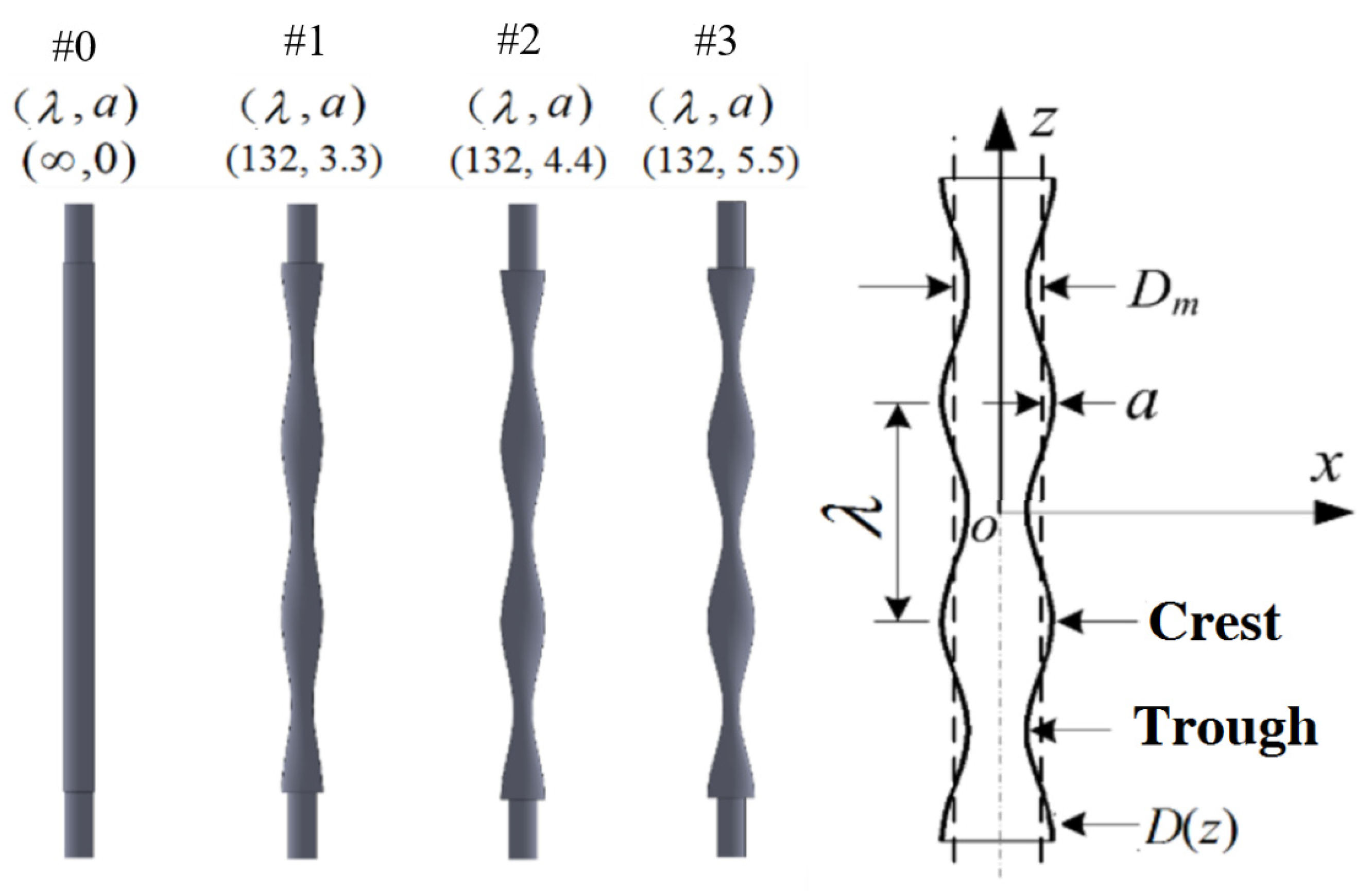

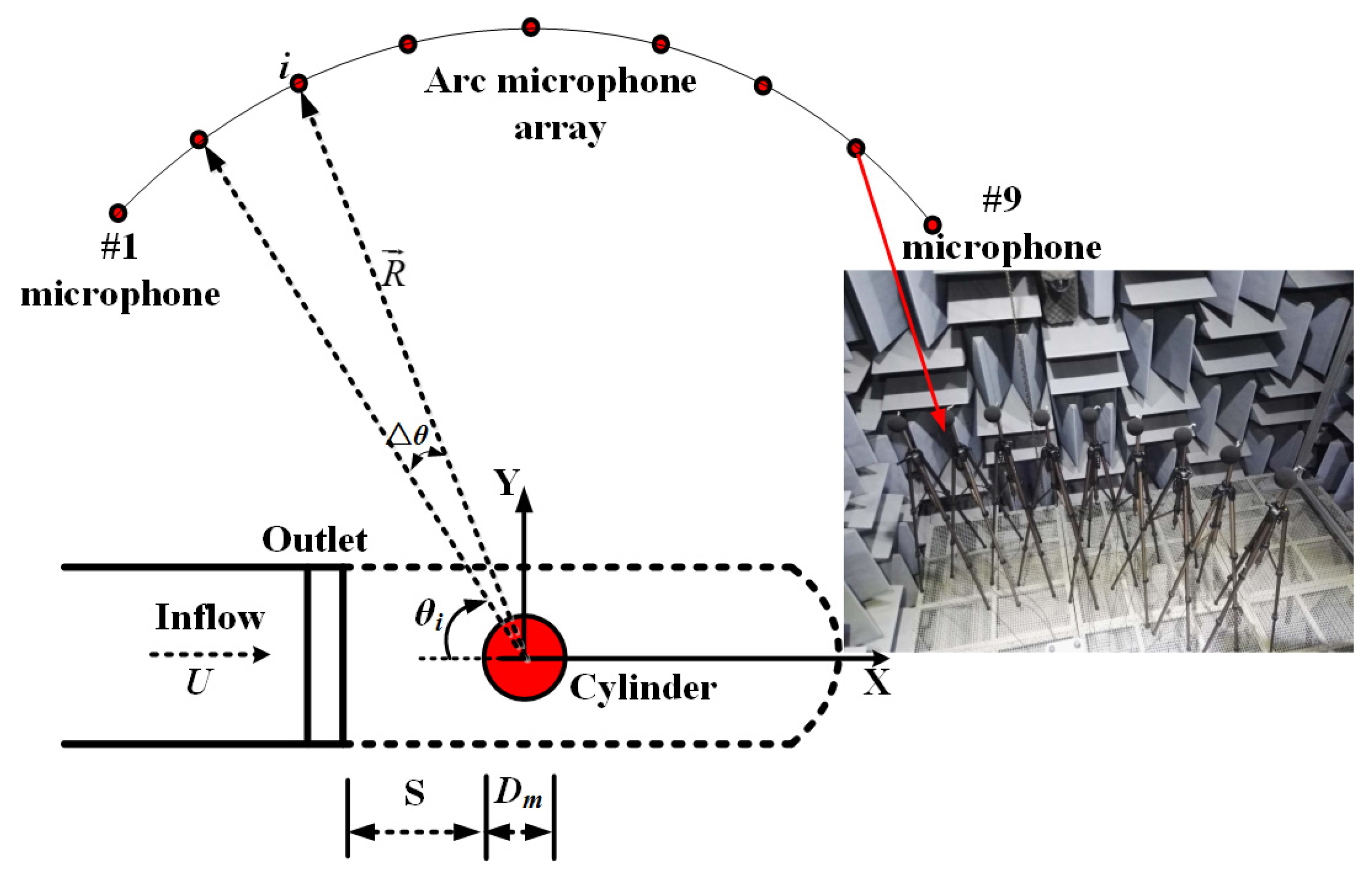
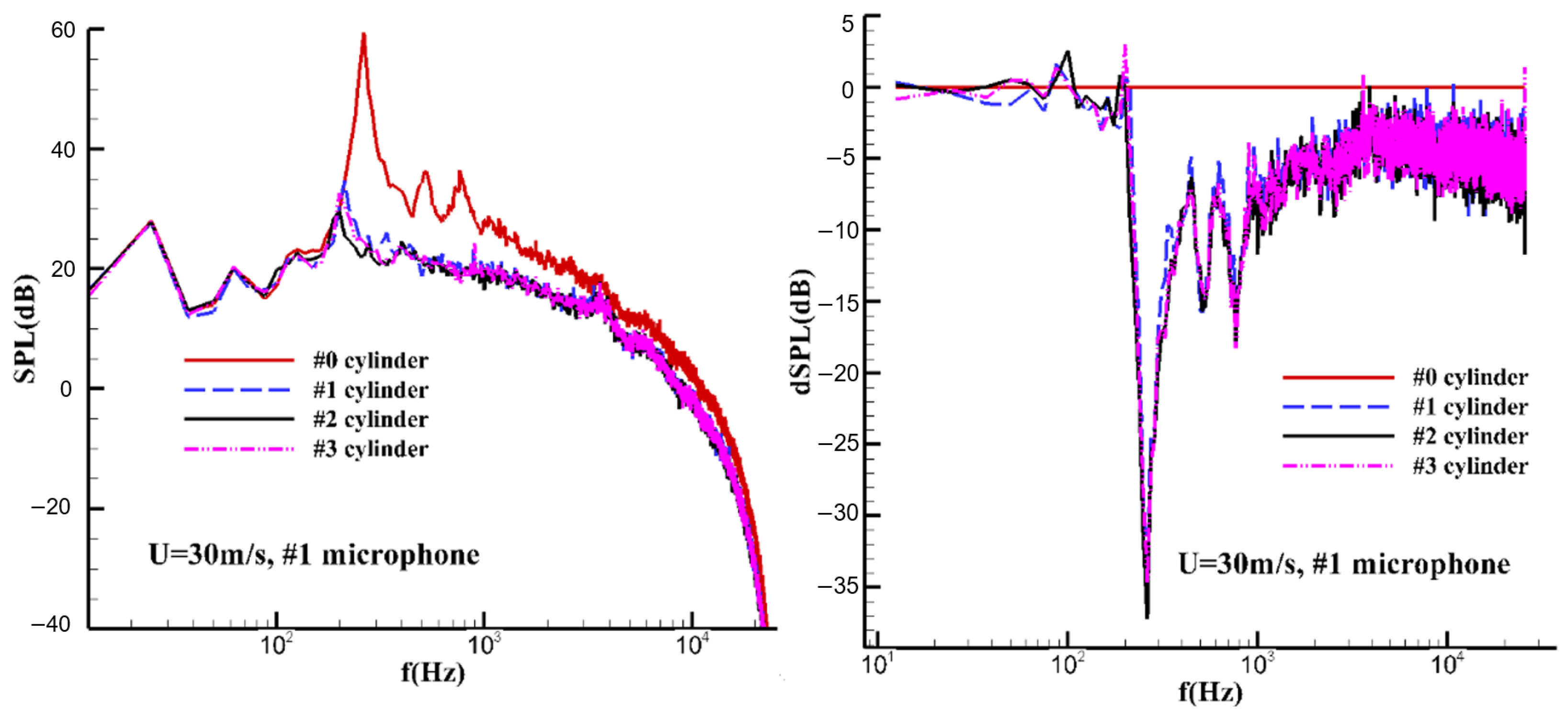
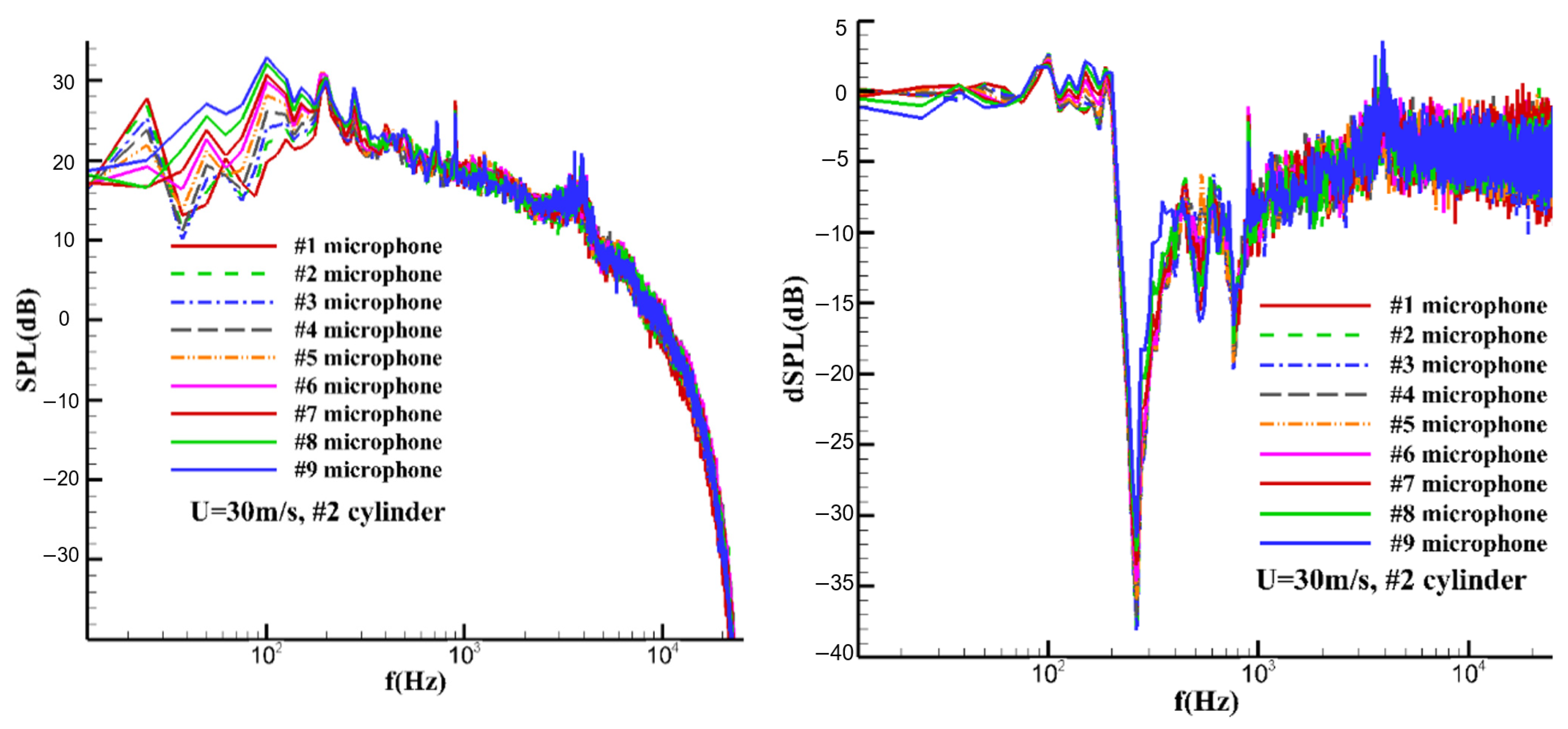
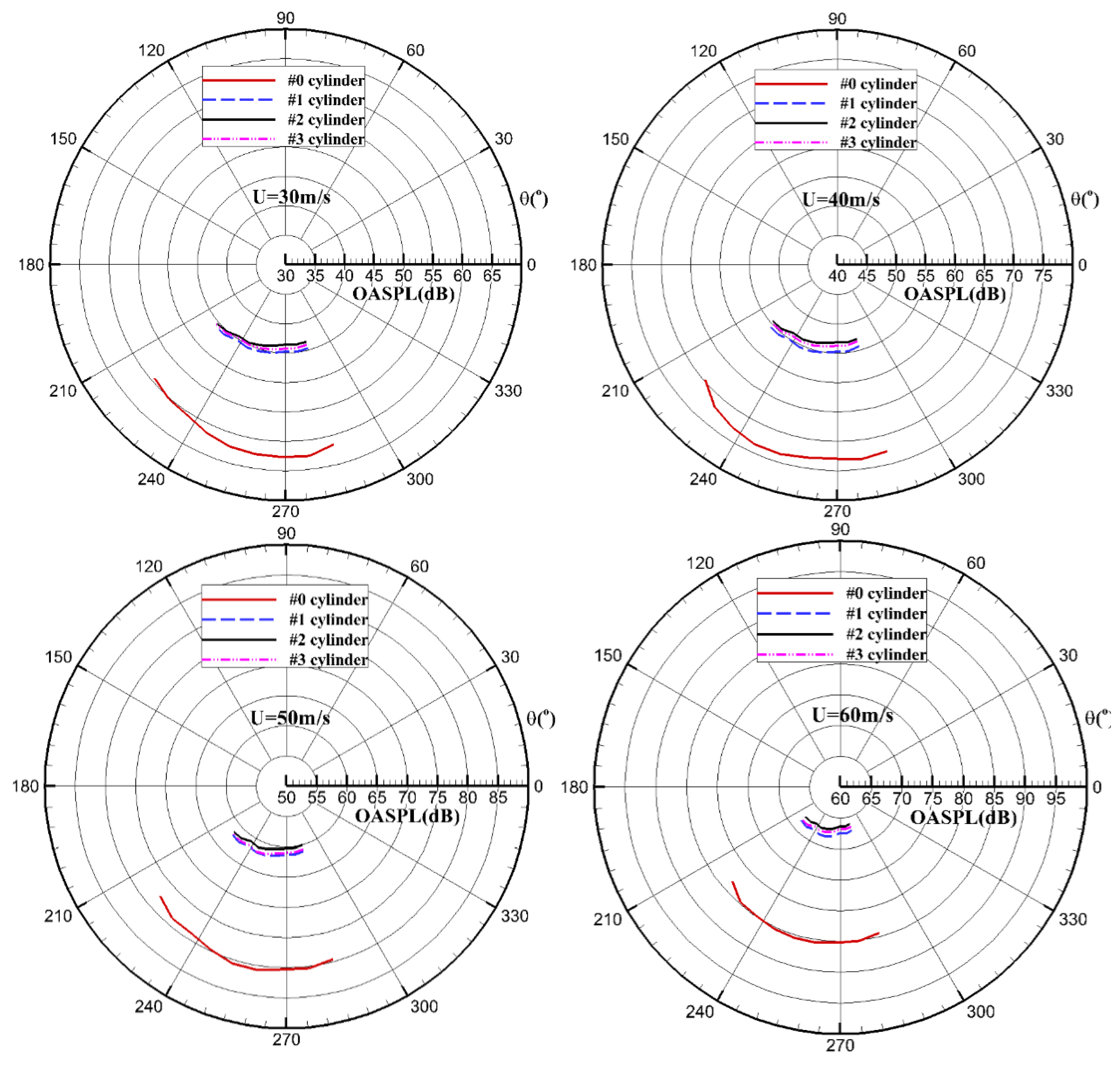
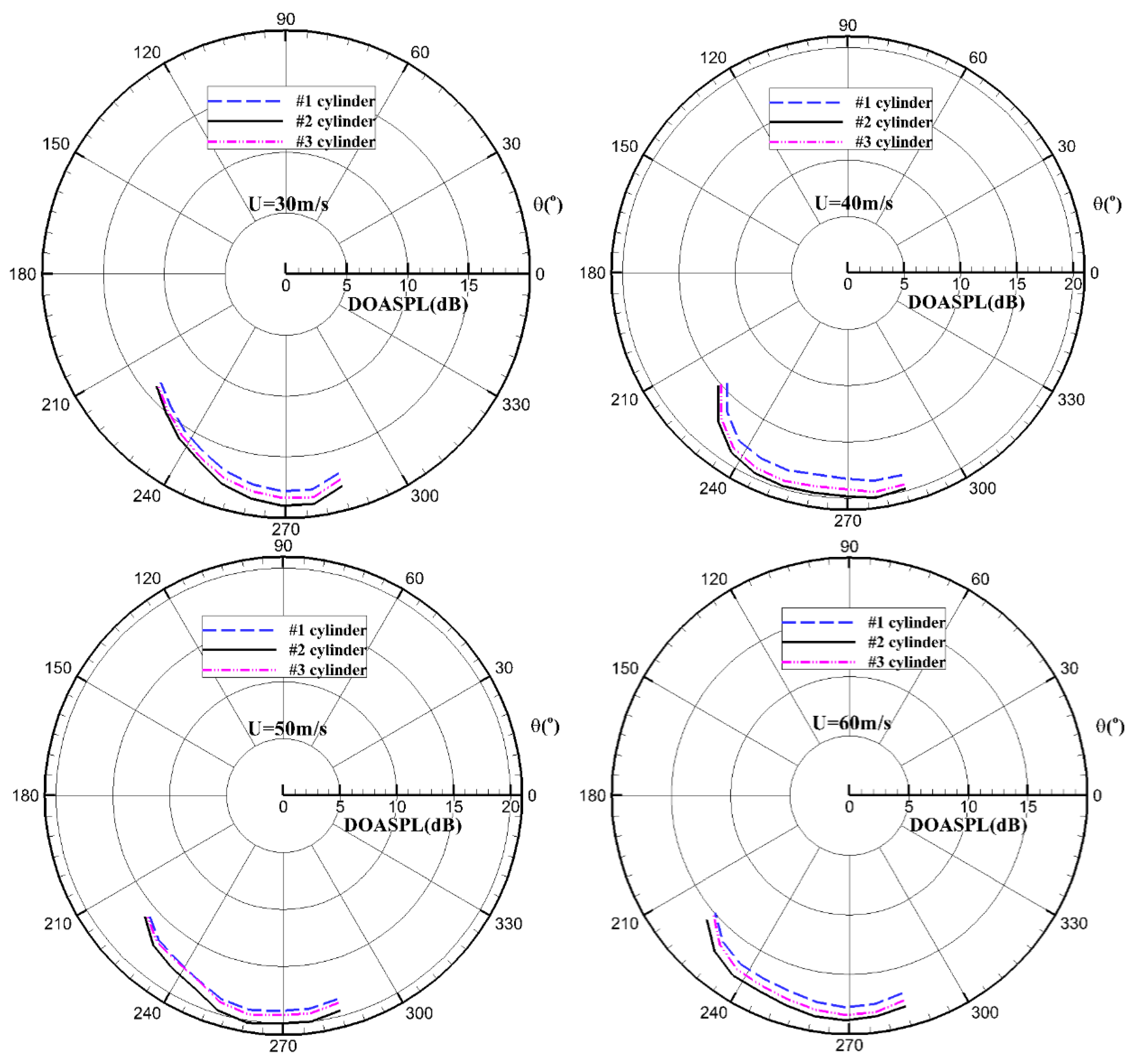
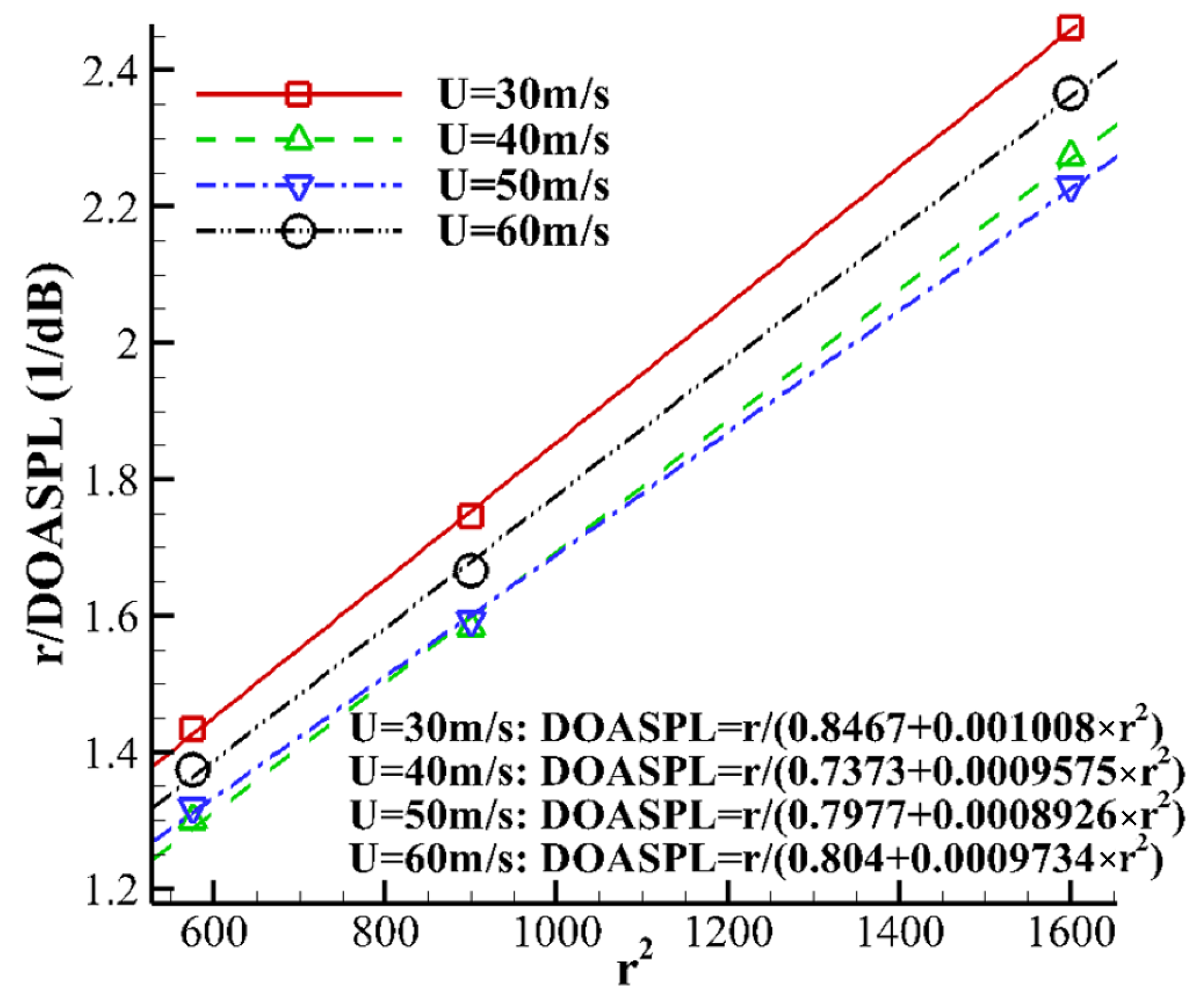
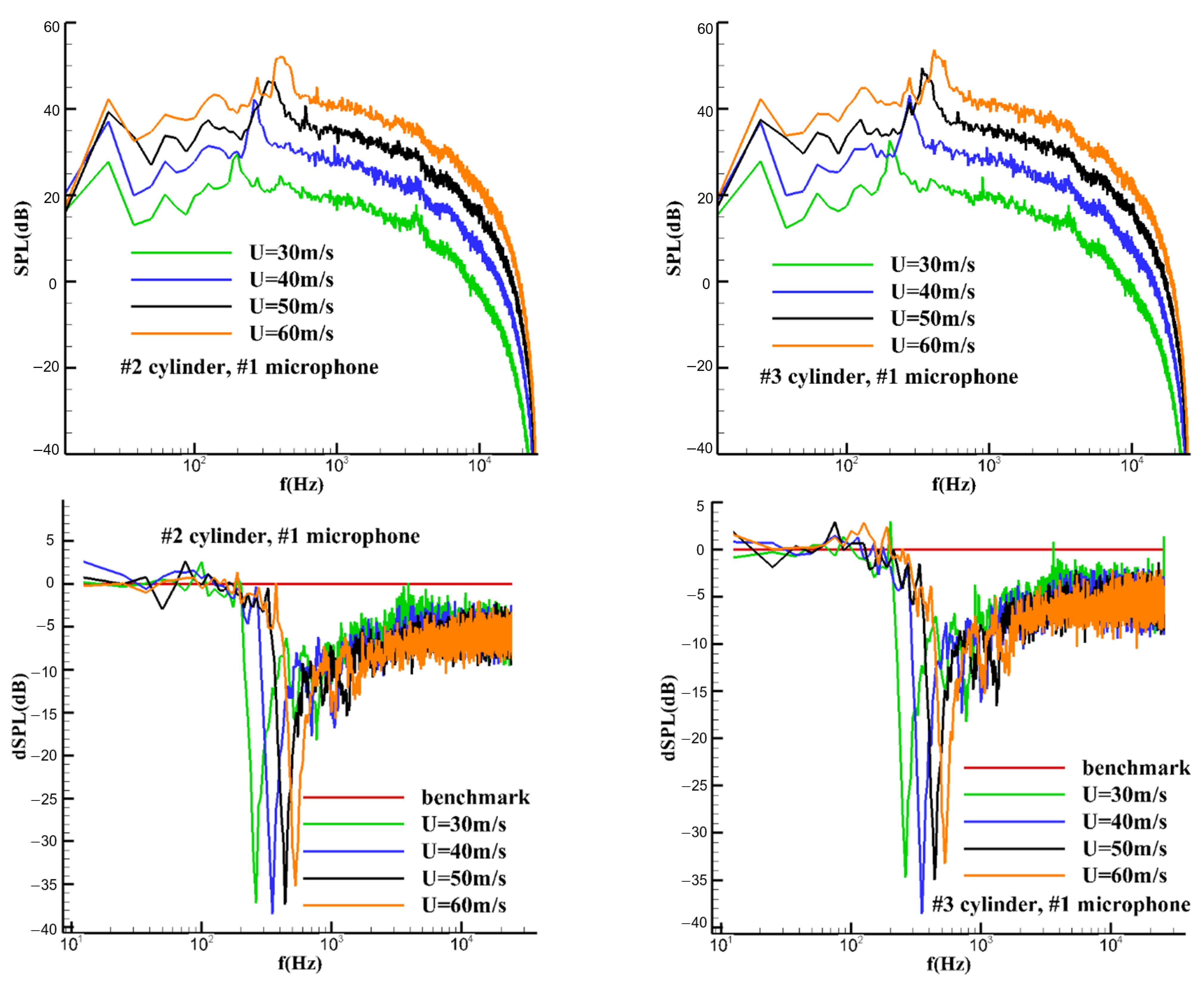

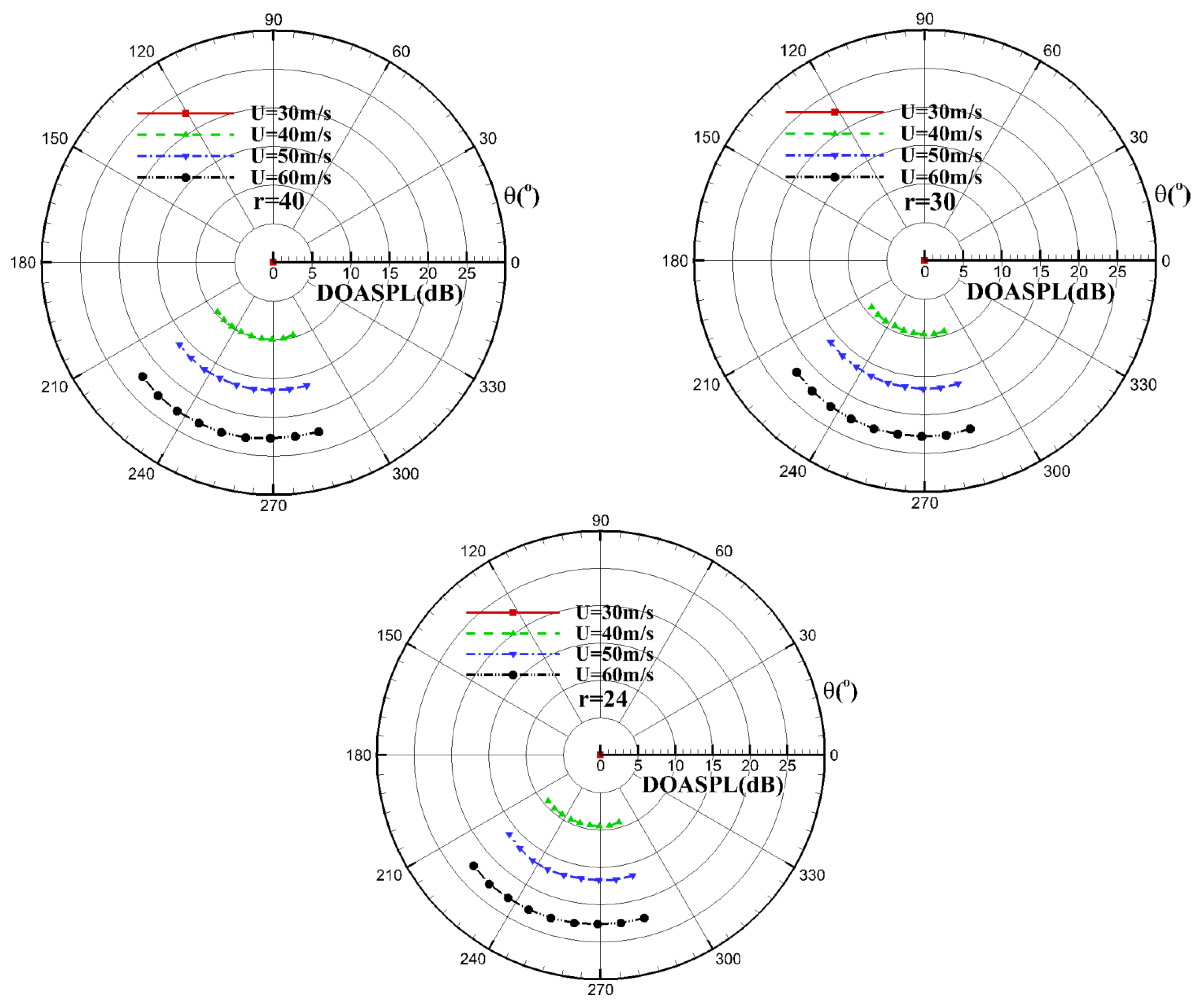
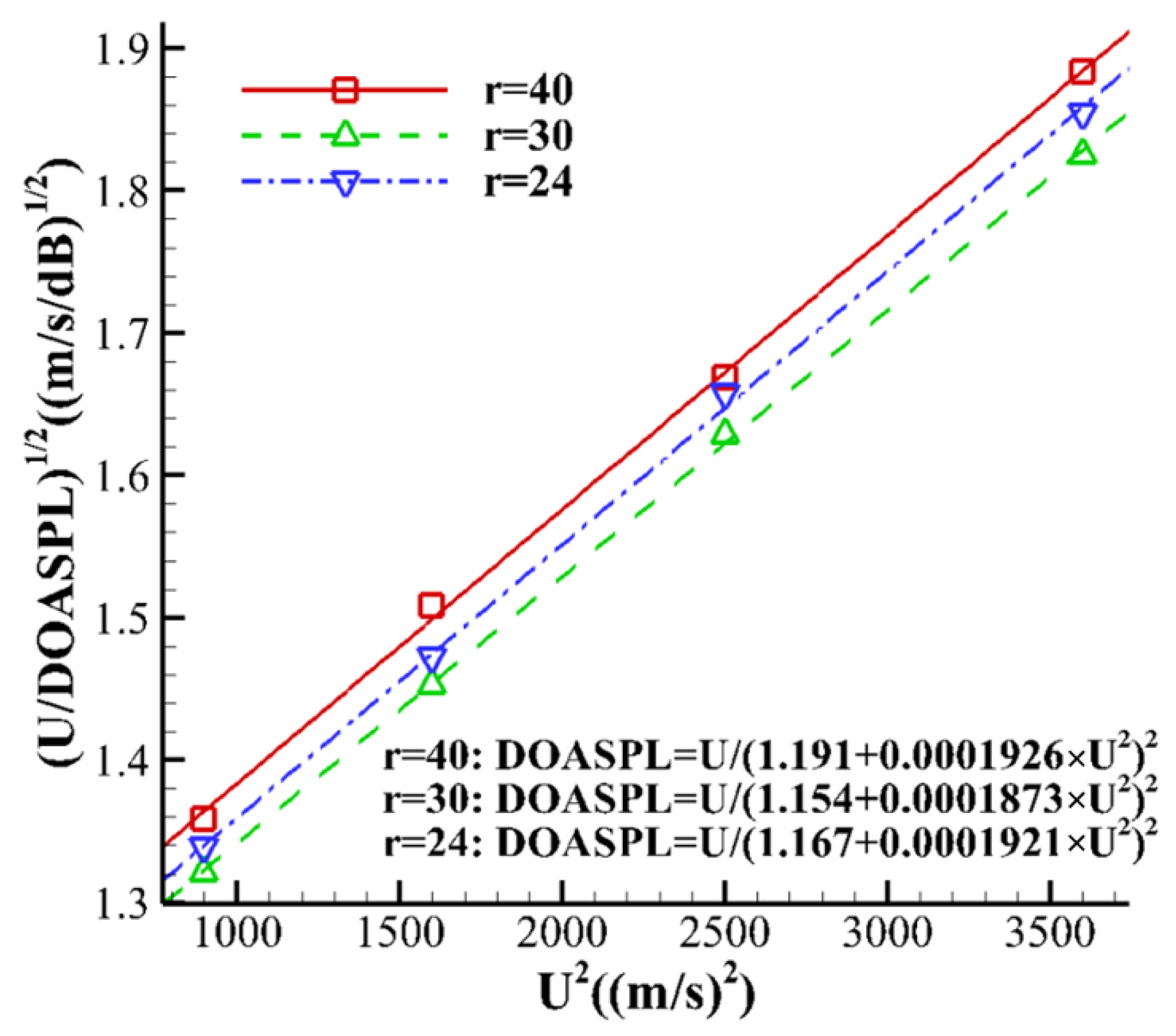

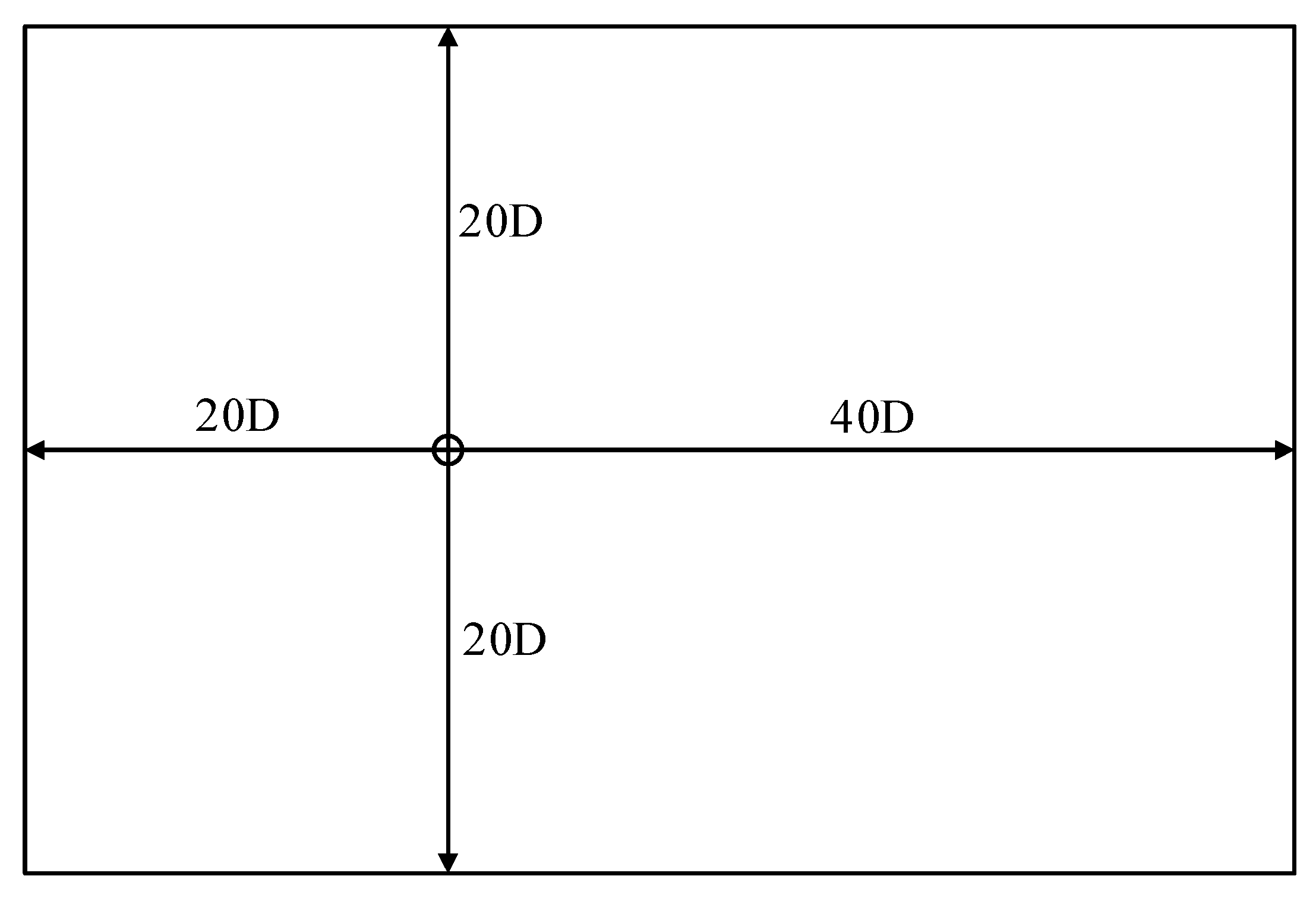
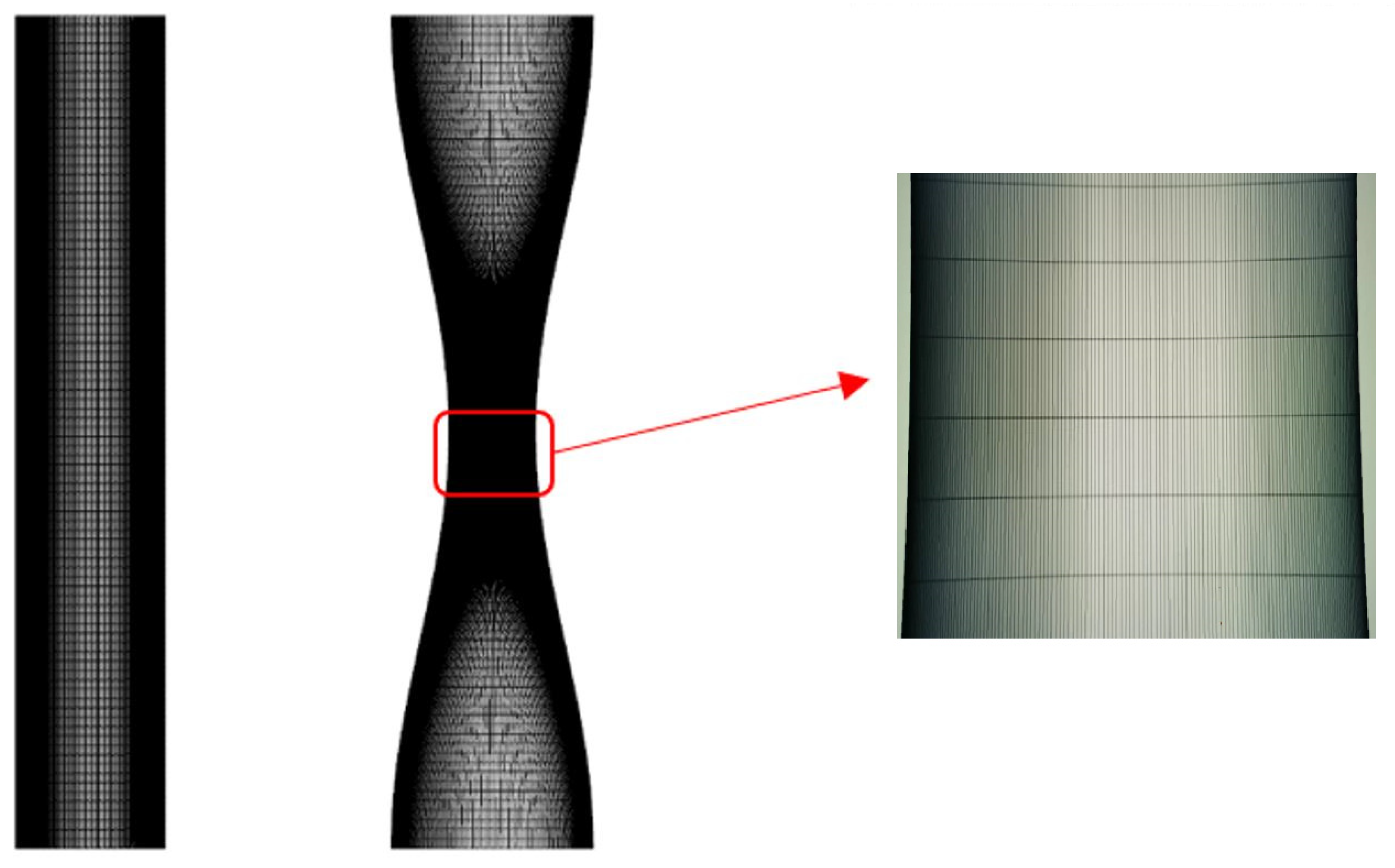
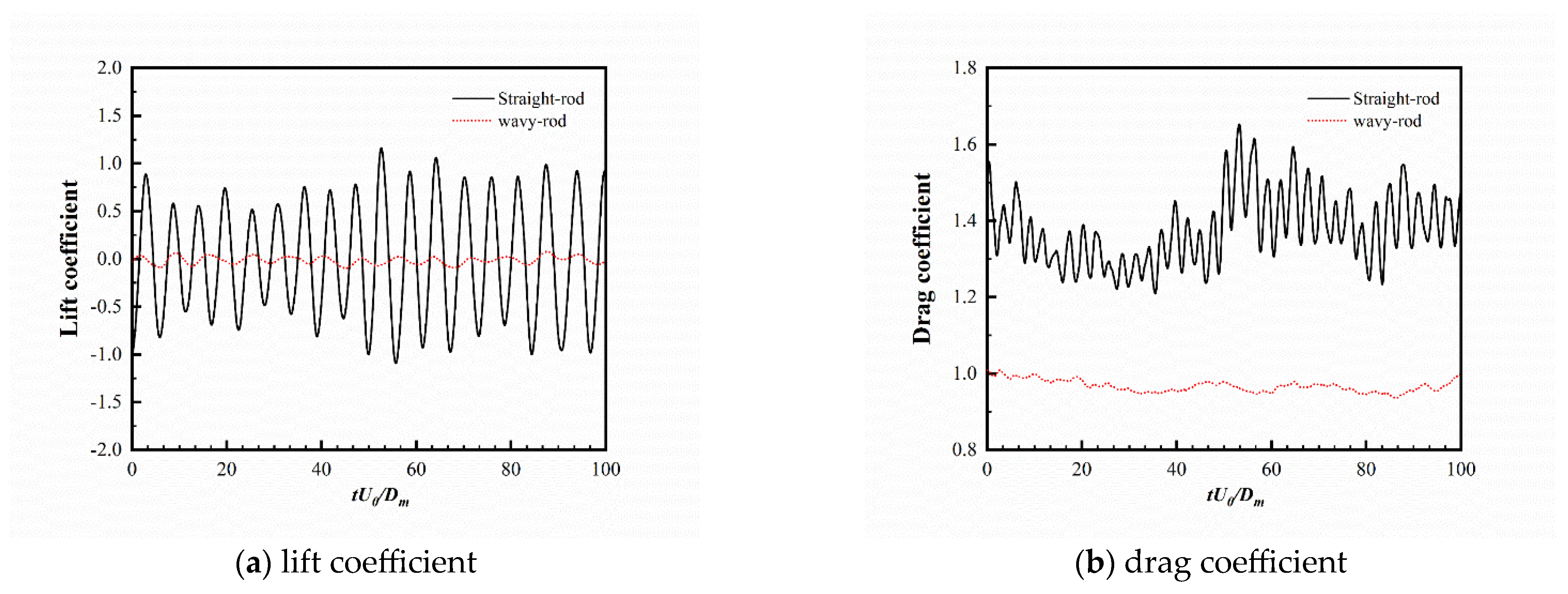
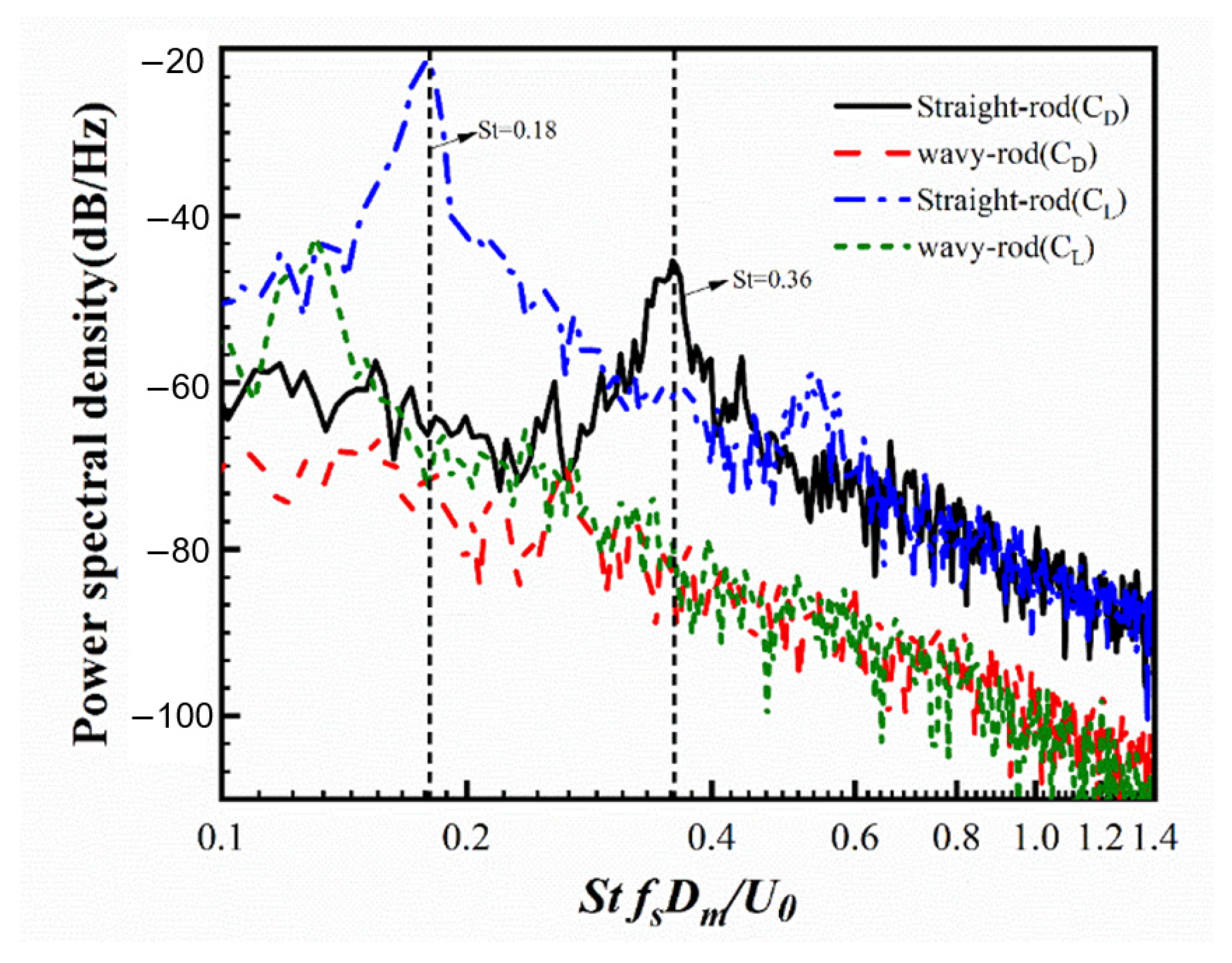
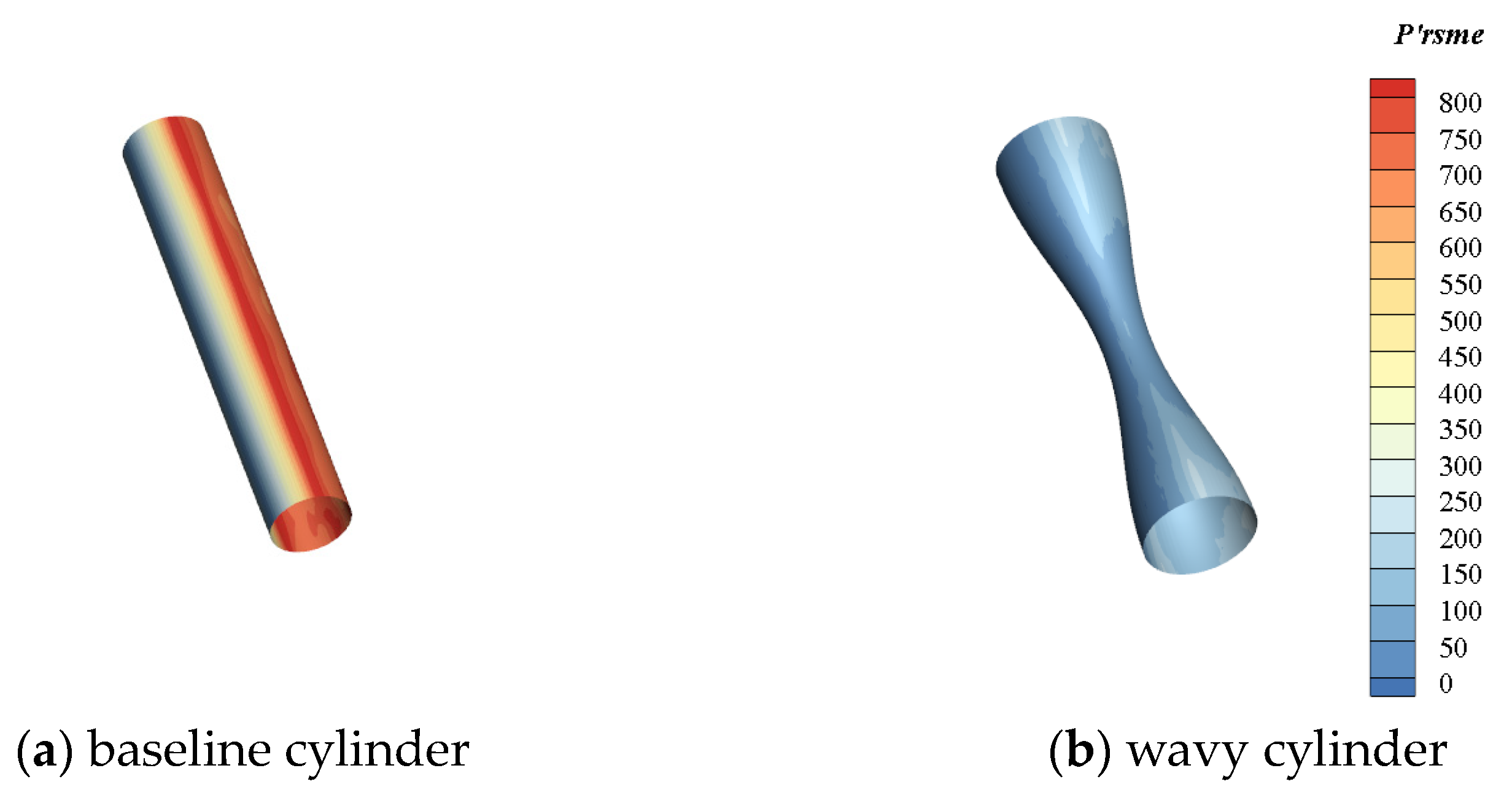

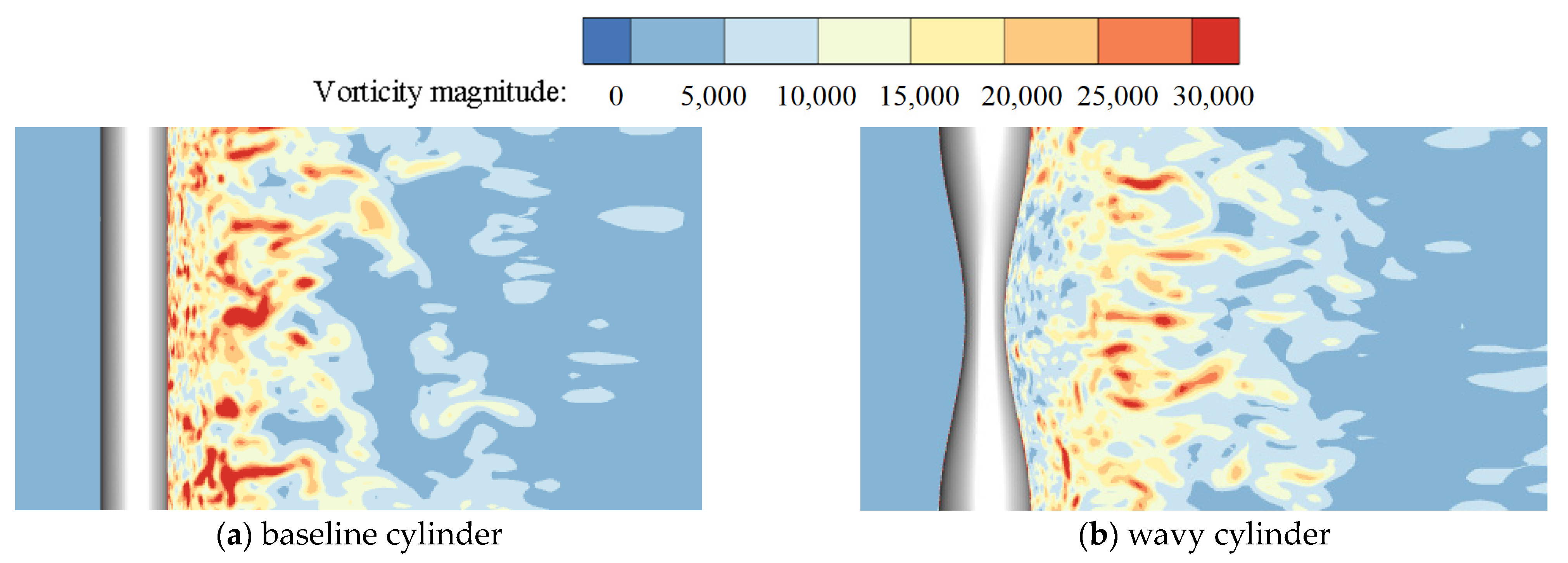
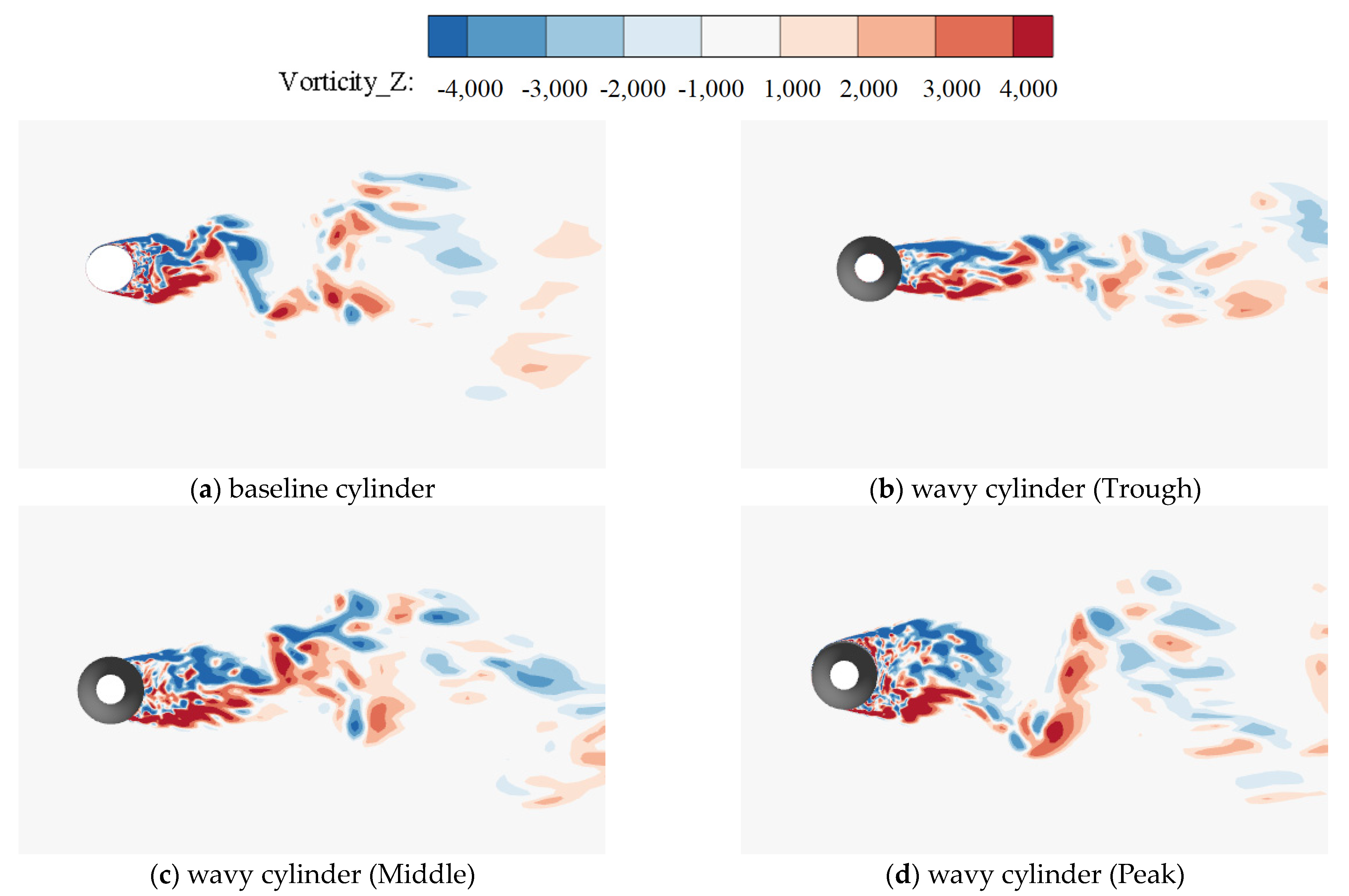

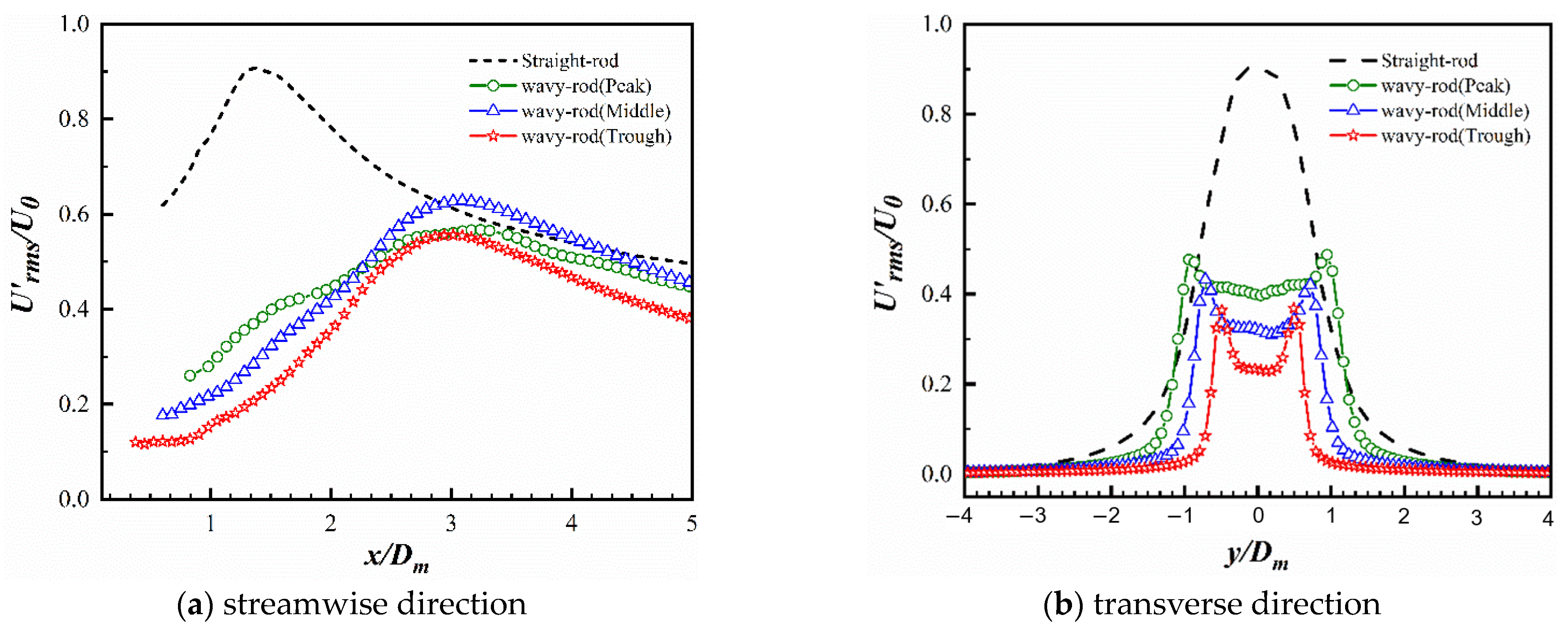
| Cylinder No. | Dm (mm) | λ (mm) | a (mm) | r = λ/a |
|---|---|---|---|---|
| #0 | 22 | ∞ | 0.01 | ∞ |
| #1 | 22 | 132 | 3.3 | 40 |
| #2 | 22 | 132 | 4.4 | 30 |
| #3 | 22 | 132 | 5.5 | 24 |
| U (m/s) | A | B |
|---|---|---|
| 30 | 0.8467 | 0.001008 |
| 40 | 0.7373 | 0.0009575 |
| 50 | 0.7977 | 0.0008926 |
| 60 | 0.804 | 0.0009734 |
| r | A | B |
|---|---|---|
| 40 | 1.191 | 0.0001926 |
| 30 | 1.154 | 0.0001873 |
| 24 | 1.167 | 0.0001921 |
Disclaimer/Publisher’s Note: The statements, opinions and data contained in all publications are solely those of the individual author(s) and contributor(s) and not of MDPI and/or the editor(s). MDPI and/or the editor(s) disclaim responsibility for any injury to people or property resulting from any ideas, methods, instructions or products referred to in the content. |
© 2023 by the authors. Licensee MDPI, Basel, Switzerland. This article is an open access article distributed under the terms and conditions of the Creative Commons Attribution (CC BY) license (https://creativecommons.org/licenses/by/4.0/).
Share and Cite
Xiao, C.; Tong, F. Experiment on Noise Reduction of a Wavy Cylinder with a Large Spanwise Wavelength and Large Aspect Ratio in Aeroacoustic Wind Tunnels. Appl. Sci. 2023, 13, 6061. https://doi.org/10.3390/app13106061
Xiao C, Tong F. Experiment on Noise Reduction of a Wavy Cylinder with a Large Spanwise Wavelength and Large Aspect Ratio in Aeroacoustic Wind Tunnels. Applied Sciences. 2023; 13(10):6061. https://doi.org/10.3390/app13106061
Chicago/Turabian StyleXiao, Chunhua, and Fan Tong. 2023. "Experiment on Noise Reduction of a Wavy Cylinder with a Large Spanwise Wavelength and Large Aspect Ratio in Aeroacoustic Wind Tunnels" Applied Sciences 13, no. 10: 6061. https://doi.org/10.3390/app13106061




